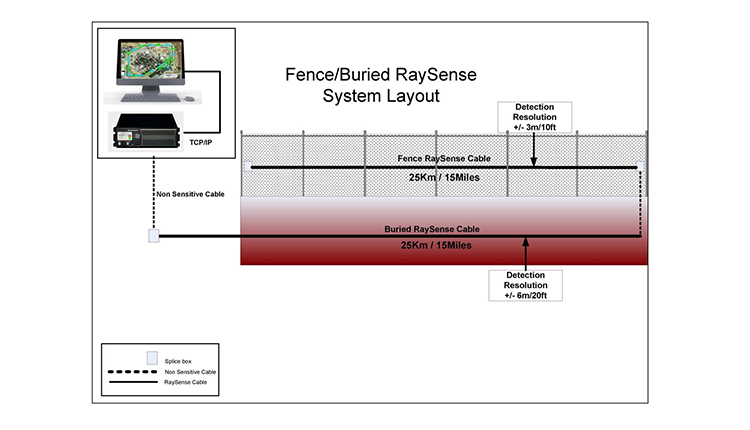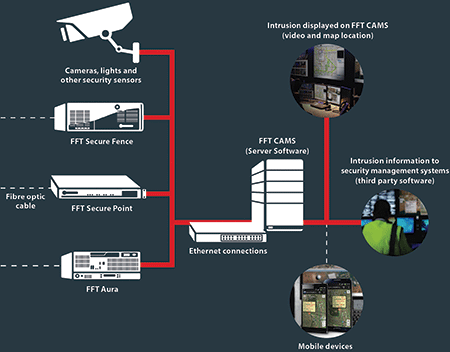How Security Fibers Are Used to Enhance the Efficiency of Security Surveillance Systems
How Security Fibers Are Used to Enhance the Efficiency of Security Surveillance Systems
Blog Article
Why Fiber Optic Safety Systems Are the Future of Defense
The shift to fiber optic security systems marks a significant improvement in the world of defense, driven by their remarkable data transmission abilities and durability to outside interferences. As the landscape of protection progresses alongside arising technologies such as AI and IoT, the potential for fiber optics to boost and redefine protection facilities comes to be progressively noticeable.
Advantages of Fiber Optic Equipments
Among the primary benefits of fiber optic systems is their premium bandwidth capability, which helps with the transmission of huge volumes of information over fars away without considerable loss. This characteristic is specifically useful for safety and security applications that require the constant monitoring and transfer of high-definition video feeds, sensor data, and other essential details. Optical fiber can fit the expanding needs of modern-day safety systems, making sure that information stays intact and reputable.
In addition, fiber optic wires are less susceptible to electromagnetic disturbance, which can be a significant problem in environments with various electronic devices. This resistance enhances the honesty of the information being sent, consequently reducing the danger of data violations or system failures. Fiber optic systems are inherently much more safe and secure than conventional copper wires, as tapping into a fiber optic line without detection is exceptionally challenging.
The durability of fiber optic cable televisions likewise adds to their charm. They are immune to ecological variables such as moisture and temperature changes, reducing upkeep prices and boosting system long life. In general, these benefits placement fiber optic systems as a robust and efficient option for modern protection facilities, making certain trustworthy and protected data transmission.
Boosted Information Transmission Rate

The ability to transmit large amounts of data swiftly promotes the seamless integration of high-definition video feeds and progressed analytics. Safety and security systems can now refine and analyze information in real-time, improving reaction times and situational awareness. Additionally, fiber optic connections sustain longer transmission distances without degradation of signal high quality, making them excellent for extensive safety networks.
The enhanced speed of fiber optic systems not only boosts the effectiveness of protection procedures but additionally lowers latency. This is especially essential in important scenarios where timely decision-making can stop safety breaches or minimize possible risks. As organizations proceed to focus on safety and effectiveness, the demand for fast and trustworthy information transmission will certainly strengthen fiber optic systems as a foundation of modern safety and security facilities.
Resistance to Interference
Fiber optic security systems constantly demonstrate phenomenal resistance to electromagnetic interference, a critical home advantage in atmospheres prone to digital sound. Unlike standard copper wires, which can be negatively influenced by electro-magnetic areas, superhigh frequency disturbance, and other kinds of electric disruption, fiber optic cable televisions use light to transmit data. This intrinsic residential property makes sure that the signals continue to be clear and unaltered, despite surrounding electronic activity.
The use of glass or plastic fibers in fiber optic modern technology creates an obstacle versus disturbance, permitting reliable data transmission even in challenging scenarios such as commercial centers, urban areas with high electronic traffic, or locations near radio towers. This particular significantly decreases the possibility this of signal deterioration or loss, making fiber optic systems especially appropriate for safety applications where stability and accuracy of information are paramount.
In addition, this resistance to disturbance improves the total performance and dependability of safety and security systems, guaranteeing that tracking and alert systems function perfectly. In a globe where safety is increasingly endangered by advanced technologies, the durability of fiber optic systems stands apart as a pivotal feature, strengthening their condition as a vital element of modern protection framework.
Cost-Effectiveness With Time
Considerable cost savings can be accomplished over time with the implementation of fiber optic security systems. While the preliminary financial investment might appear higher compared to typical copper-based systems, the long-lasting financial benefits end up being noticeable via minimized operational and upkeep expenses (fiber security). Fiber optic cables are inherently much more durable and much less vulnerable to environmental elements, which converts to reduce replacement and fixing costs over their lifespan
Moreover, fiber optic systems require much less power to operate, which further decreases energy expenses. Improved data transmission abilities permit fewer repeaters and amplifiers, decreasing equipment financial investment and simplifying installation procedures. The scalability of these systems likewise adds to cost-effectiveness, as companies can broaden their safety and security facilities without incurring considerable extra expenditures.
One more variable to consider is the raised performance in surveillance and response capacities special info that fiber optics offer. Boosted real-time data transmission can bring about quicker case response times, potentially mitigating losses and responsibilities associated with safety and security breaches. In sum, the long-term advantages of fiber optic security systems not just validate the initial expenditure but additionally position them as an economically prudent selection for companies looking for robust defense remedies.

Future Developments in Security
Advancing modern technologies are established to reinvent safety systems, incorporating expert system (AI) and artificial intelligence to improve danger detection and feedback abilities. These advancements will enable safety and security systems to evaluate vast quantities of information in real-time, identifying patterns and anomalies that indicate possible dangers. This aggressive technique will allow faster decision-making and extra reliable case actions.
Furthermore, the incorporation of the Web of Points (IoT) is leading the way for interconnected security gadgets, offering extensive surveillance and tracking. Smart sensing units can relay details about environmental adjustments, while automated notifies can inform safety personnel right away of dubious activities.
Moreover, the development of biometric modern technologies will certainly additionally strengthen security mechanisms. Facial acknowledgment, finger print scanning, and retina identification are coming to be more sophisticated, supplying layers of verification that are challenging to bypass.
Conclusion
Finally, fiber optic protection systems stand for a significant development in security innovation, using unrivaled data transmission speed, resistance to electromagnetic interference, and lasting cost-effectiveness. As the demand for advanced safety and security services proceeds to expand, the combination of fiber optics with emerging innovations such as AI, IoT, and biometrics will certainly even more improve safety facilities (fiber security). The combination of these developments will ensure a more protected and responsive atmosphere, solidifying fiber optics as a keystone of future protection systems
Report this page